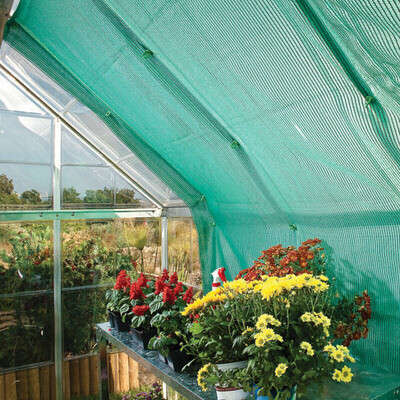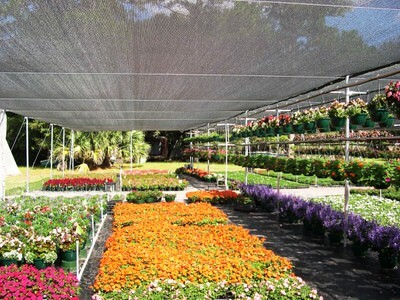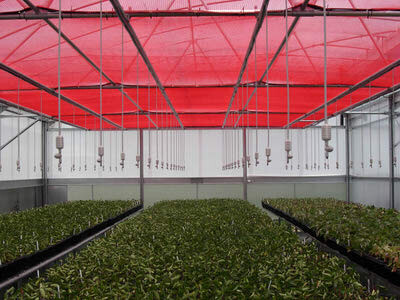Shade Material Buyer's Guide
Shade cloth is a lightweight knitted fabric, often made of polyethylene, which provides protection from the sun. Shade cloth is available in shade densities from 30% to 90%. It can be used with greenhouses, hoop structures, or in field applications. Additional uses include fences, windscreens, retail area shading, and as privacy barrier.
Shade material is rot and mildew resistant, doesn’t become brittle, and is water permeable. It offers superior ventilation, improves light diffusion, and keeps greenhouses cooler. As a result, shade cloth can help to lower energy costs by reducing the need for electrical cooling. Installing and removing shade cloth is quick and easy.
Shade cloth benefits include:
- Creates shade to helps lower temperatures and exposure
- Reduces UV penetration and solar hear gain
- Protects against wind damage and dust particles
- Lightweight material makes ideal for multiple applications
Common shade cloth applications:
- Cover greenhouses, gardens, play areas, athletic fields, decks, porches, and any outdoor area that requires shaded space
- Create temporary structures for camping, beach trips, craft fairs, and outdoor festivals
- Covering automobiles, boats, and motorcycles to prevent sun damage
- Use as an odor control barrier in commercial and medical growing operations
- Create temporary fencing
- Make field cages to help prevent cross pollination and preserve the integrity of open pollinated crops
- Place over the top of trucks and trailers to keep debris, leaves and peat moss from blowing out
- Cover vents, windows and doors to eliminate insect penetration
What is Aluminet shade cloth and how is it beneficial in my greenhouse?
Aluminet shade cloth helps create an optimum growing climate because it reflects the sun's radiation rather than absorbing it. Reflective shade assists in controlling the light, temperature and humidity balance, and are energy-saving. Maximum reflection means lower daytime temperature with high energy savings at night, keeping crop temperatures close to ambient. Aluminet shade material prevents heat buildup and produces healthier plants in greenhouses by reflecting heat and filtering strong sunlight.
Aluminet shade cloth can provide up to a 25% energy savings and is available in 30 to 80% shade. Aluminet reduces plant stress and improves the efficiency of greenhouse systems, offering both daytime cooling and nighttime heat retention.
What is the difference between standard shade cloth and Aluminet shade cloth?
Standard shade cloth is an affordable, durable means of protecting plants and crops from direct sunlight. When shade cloth is used on a growing structure, it blocks a percentage of light from penetrating, hence keeping plants more comfortable. This type of shade material is appropriate for general gardening, farming and greenhouse applications and is widely used in the commercial farming and gardening industry.
Aluminet shade cloth is a high-quality material that provides solar reflection, cooling and heat retention. Aluminet shade cloth helps to keep the greenhouse cool during the day without letting the heat escape at night. This material can be used either on the interior or exterior of a greenhouse.
Which shade material should I use?
Our shade material comes in several shade densities and can be used for multiple applications. Shade material helps protect livestock, pets, plants, and people from direct sunlight and also works well as a privacy barrier or windscreen.
Typically, growers use mostly 50% to 60% density, with the high densities of 70% to 80% used in southern states and for light-sensitive plants in all zones. Many people find that using a high-density shade on roofs and a lower density shade on walls is a good method for creating ideal shade conditions. Vegetable gardeners should check with their local University Agricultural Extension office to determine the shade cloth density that is appropriate for both the climate and plant variety.
What does the shade percentage mean in relation to the shade material?
Shade density is determined by the percentage of light blocked by the shade. For example, 80% shade allows only 20% of light to pass through it. A shade percentage of 30 to 50% is ideal for vegetables, while 80 to 90% is preferred for personal use. Below is a general guide for shade cloth application:
30% Shade

Uses:
Snapdragons
Chrysanthemums
Geraniums
40% Shade

Uses:
- Lilies
- Bed Planting
- Caladiums
50% Shade

Uses:
- Azaleas
- Begonias
- Camellias
- Gloxinias
- African Violets
- Poinsettias
- Lilies
- Bed Planting
- Caladiums
- Orchids
60% Shade

Uses:
- Fern
- Anthurium
- Dracaena
- Philodendron
- Livestock
- Pachysandra
- Ivy
70% Shade

Uses:
- Fern
- Palms
- Evergreens
- Anthurium
- Dracaena
- Philodendron
- Livestock
80% Shade

Uses:
- Fern
- Palms
- Evergreens
90% Shade

Uses:
- Nurseries
- Greenhouses
- Patios
- Porches
What do the terms "seaming,” "cutting,” and “taping” mean?
Seaming means that two pieces of standard size shade cloth are joined together to create a larger, custom size shade cloth. When cutting, a width of shade cloth is cut from a standard width into a smaller, custom width. Taping, or finishing by adding a reinforcing tape border around the shade panels, can also be done by our staff. In addition to a neat appearance, finishing the edges around your shade material makes it considerably easier to work with and mount.
My application is unique. Do you take custom orders and if so, will you add grommets?
Yes, custom shade cloth sizes are available. Grommets can be added as well.
Reinforcing tape must be used in conjunction with grommets to prevent them from pulling through the shade material.
When placing a custom order please specify the following in the special instructions section at checkout:
The size (length x width), and the placement and spacing of grommets, if applicable, as well as any seaming, cutting, and taping information.
Please be advised that there is a small panel charge on orders less than 300 square feet.
What are some of the accessories I may need to go with my shade material?
Snugger tie downs are ideal for use with shade cloth that has grommets. For shade cloth without grommets, shade clips can be used to attach your shade cloth to structures or wire supports. No tools are required, and the clips simply snap into place.
We also offer poly clips for easily securing both shade cloth and netting to frames, wires and cables. To attach shade cloth to pipe without tape or screws, we recommend our labor saver fabric clips as they will not tear your valuable fabric.
Please contact us for assistance in choosing the right accessories for your shade cloth application.
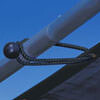
Snugger Tie Downs
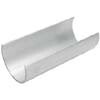
Labor Saver Fabric Clips
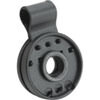
Shade Clips
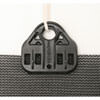
Poly Clips

Rope
Will water go through shade cloth material?
Shade cloth is water permeable so that rainwater, sprinklers and irrigation systems can keep your plants hydrated.
Gothic Arch Greenhouses has everything from decorative colored shade cloth to industrial grade black out shade material. Call one of experts today at 1-800-531-4769 to get started on your project.

